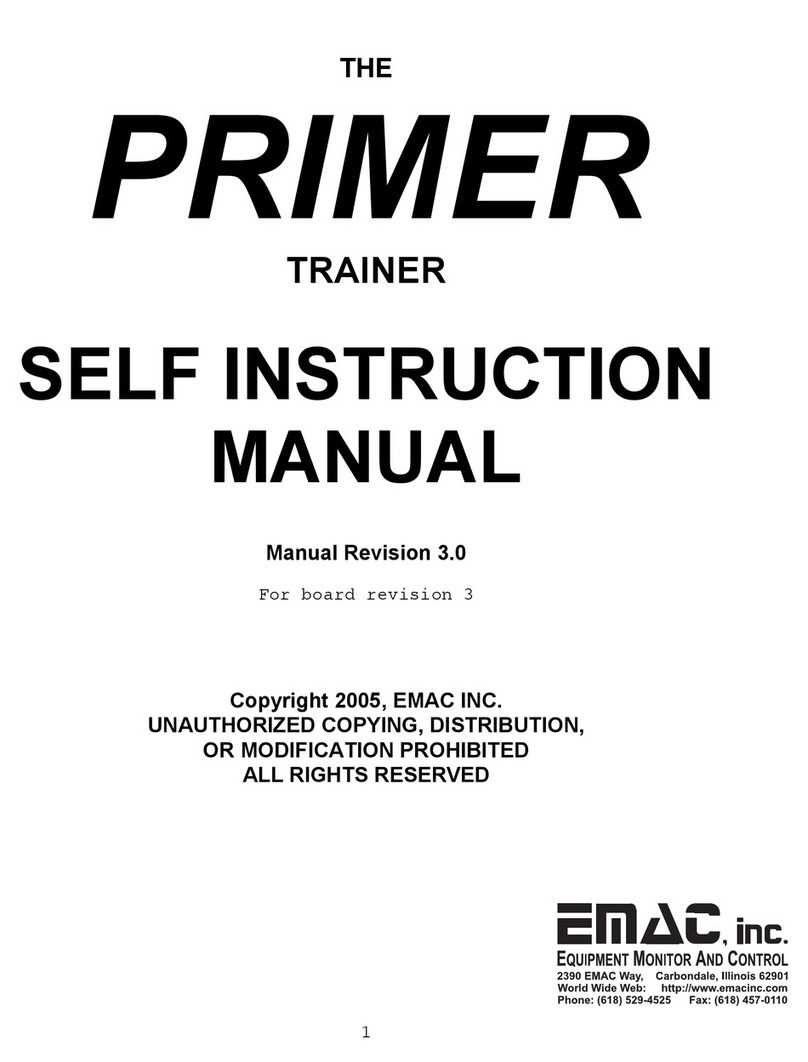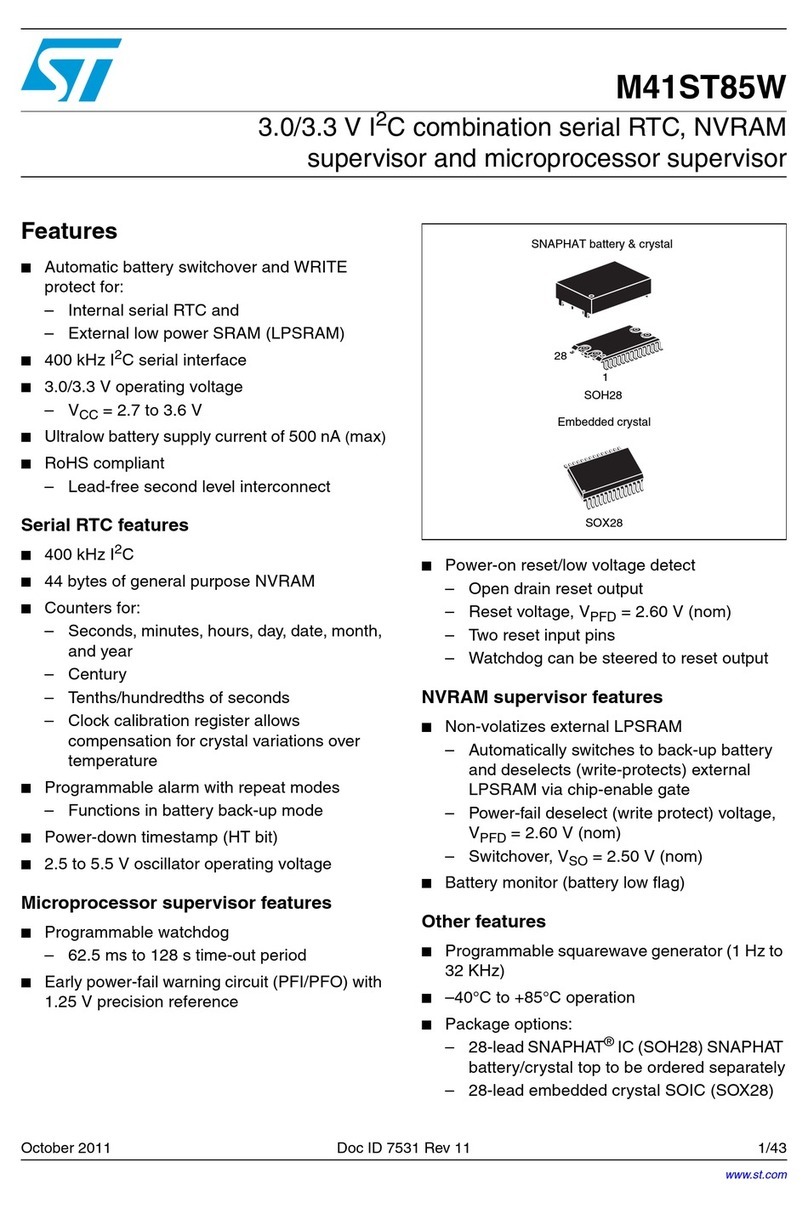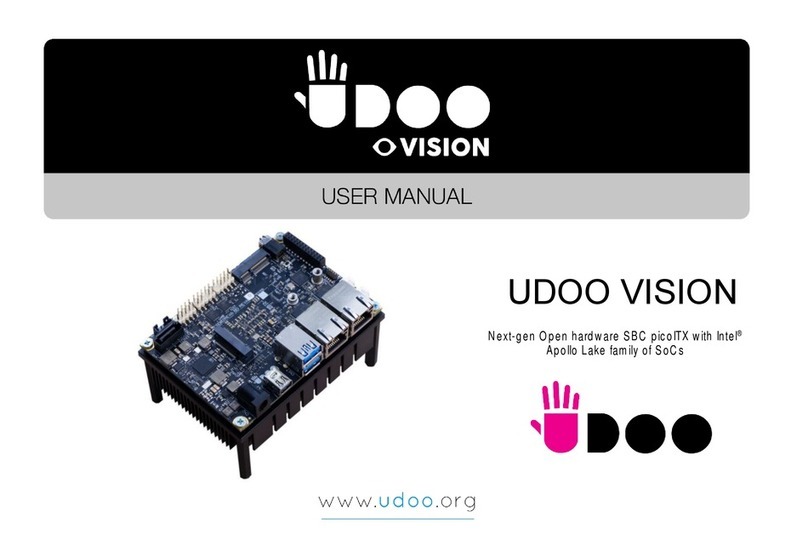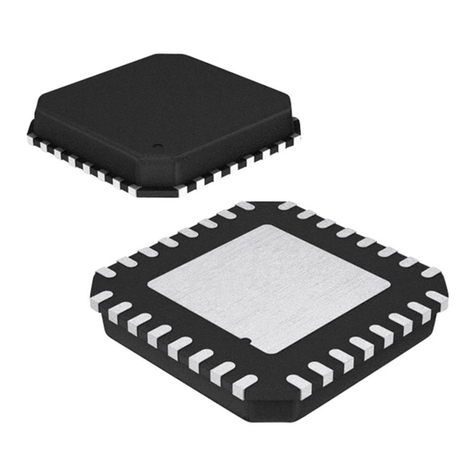EMAC PCM-9373 User manual

PCM-9373
VIA Eden SBC with CPU, LCD,
LVDS, Ethernet and Audio
User’s Manual

PCM-9373 User’s Manual ii
Copyright
This document is copyrighted, © 2003. All rights are reserved. The orig-
inal manufacturer reserves the right to make improvements to the prod-
ucts described in this manual at any time without notice.
No part of this manual may be reproduced, copied, translated or transmit-
ted in any form or by any means without the prior written permission of
the original manufacturer. Information provided in this manual is
intended to be accurate and reliable. However, the original manufacturer
assumes no responsibility for its use, nor for any infringements upon the
rights of third parties that may result from such use.
Acknowledgements
Award is a trademark of Award Software International, Inc.
VIA is a trademark of VIA Technologies, Inc.
IBM, PC/AT, PS/2 and VGA are trademarks of International Business
Machines Corporation.
Intel, Pentium, Celeron, and MMX are registered trademarks of Intel Cor-
poration.
Microsoft Windows® is a registered trademark of Microsoft Corp.
RTL is a trademark of Realtek Semi-Conductor Co., Ltd.
ESS is a trademark of ESS Technology, Inc.
UMC is a trademark of United Microelectronics Corporation.
SMI is a trademark of Silicon Motion, Inc.
Creative is a trademark of Creative Technology LTD.
All other product names or trademarks are properties of their respective
owners.
For more informationon this and other EMAC products,please visit
our websites at: http://www.emacinc.com
For technical support and service, please visit our support website at:
http://www.emacinc.com/support/
This manual is for the PCM-9373.
Part No. 2006937310 1st Edition
Printed in Taiwan August 2003

iii
Packing List
Before you begin installing your card, please make sure that the following
materials have been shipped:
• 1 PCM-9373 all-in-one single board computer
• 1 startup manual
• CD-ROM or disks for utility, drivers, and manual (in PDF format)
• 1 3.5" IDE flat cable 40-pin to 40-pin (part no: 1701440351)
• 1 keyboard/ PS2 monse cable (part no. 1700060202)
• 1 second serial port cable (part no.1701140201)
• 1 parallel port cable (part no. 1700260250)
• 1 Audio cable (part no. 1703100152)
• 1 USB cable (part no. 1703100121)
If any of these items are missing or damaged, contact your distributor or
sales representative immediately.
Model No. List Description
PCM-9373F-J0A1 W/ Eden-400 CPU and heat sink
PCM-9373F-M0A1 W/ Eden-667 CPU and heat sink
PCM-9373F-S0A1 W/ C3-1GHz CPU and heat sink W/ FAN
Caution!
Achtung!
Possible danger of explosion if batteries (if any)
are incorrectly replaced.
Replace only with the same or equivalent type
recommended by the manufacturer.
Dispose of used batteries (if any) according to
the manufacturer's instructions.

PCM-9373 User’s Manual iv
Additional Information and Assistance
1.Visit theEMAC, Inc. web site at www.emacinc.com where you can
find the latest information about the product.
2.Contact your distributor, sales representative, or EMAC, Inc customer
service for technical support if you need additional assistance.
Please have the following information ready before you call:
•Product name,serial number and invoice
•Description of your peripheral attachments
•Description of your software (operating system, version, application
software, etc.)
•A complete description of the problem
•The exact wording of any error messages

v Table of Contents
Contents
Chapter 1 Introduction ......................................................2
1.1 Introduction ....................................................................... 2
1.1.1 Highly integrated multimedia SBC................................. 2
1.2 Features ............................................................................. 3
1.3 Specifications .................................................................... 3
1.3.1 Standard 3.5" Biscuit SBC Functions............................. 3
1.3.2 VGA/LCD Interface ....................................................... 4
1.3.3 Ethernet Interface............................................................ 4
1.3.4 Audio Function ............................................................... 4
1.3.5 Mechanical and Environmental ...................................... 4
1.4 Board layout: dimensions.................................................. 5
Chapter 2 Installation ........................................................8
2.1 Jumpers.............................................................................. 8
Table 2.1:Jumpers........................................................... 8
2.2 Connectors......................................................................... 8
Table 2.2:Connectors ...................................................... 8
2.3 Locating jumpers............................................................. 10
Figure 2.1:Jumper locations.......................................... 10
2.4 Locating Connectors ........................... 11
Figure 2.2:Connectors (component side)...................... 11
Figure 2.3:Connectors (solder side).............................. 12
2.5 Setting Jumpers ............................................................... 13
2.6 Clear CMOS (S2)............................................................ 14
Table 2.3:CMOS clear (S2) .......................................... 14
2.7 Installing DIMMs............................................................ 15
2.8 IDE, CDROM hard drive connector (CN11) .................. 15
2.8.1 Connecting the hard drive............................................. 15
2.9 Solid State Disk............................................................... 16
2.9.1 CompactFlash (CN22) .................................................. 16
2.10 Optional floppy drive connector (CN23) ........................ 16
2.10.1 Connecting the floppy drive ......................................... 16
2.11 Parallel port connector (CN15) ....................................... 17
2.12 Keyboard and PS/2 mouse connector (CN18) ................ 17
2.13 Power & HDD LED, Reset Button Connector
(CN16, S3) ...................................................................... 17
2.13.1 Power & HDD LED (CN16) ........................................ 17
2.13.2 Reset switch (S3) .......................................................... 18
2.14 Power connectors (CN9, CN7, CN2) .............................. 18
2.14.1 Peripheral power connector, -5 V, -12 V (CN9)......... 18
2.14.2 Main power connector, +5 V, +12 V (CN7)................ 18

PCM-9373 User’s Manual vi
2.14.3 CPU Fan power supply connector (CN2) ..................... 18
2.15 ATX power control connector (CN1, CN8).................... 18
2.15.1 ATX feature connector (CN1) and soft power switch
connector (CN8) ........................................................... 18
Figure 2.4:Wiring for ATX soft power switch function19
2.16 Audio interfaces (CN14) ................................................. 19
2.16.1 Audio connector (CN14) .............................................. 19
2.17 COM port connector (CN20,CN12)................................ 20
2.17.1 COM2 RS-232/422/485 setting (pin 1-6 of JP1).......... 20
Table 2.4: JP1: COM2 RS-232/422/485 select............. 20
2.18 VGA/LCD/LVDS interface connections ........................ 20
2.18.1 CRT display connector (CN21) .................................... 20
2.18.2 Flat panel display connector (CN4) .............................. 20
2.18.3 Extension flat panel connector (CN3) .......................... 21
2.18.4 LVDS LCD panel connector (CN6) ............................. 21
2.18.5 Panel type selection (S1)............................................... 21
Table 2.5:S3 Panel Type select.................................... 21
2.19 TV-out interface (optional) (CN4, CN3)......................... 22
2.20 Ethernet configuration..................................................... 22
2.20.1 100Base-T connector (CN17)....................................... 22
2.20.2 Network boot ................................................................ 22
2.21 Watchdog timer configuration ........................................ 23
2.21.1 Watchdog timer action (pin 7-10 of JP1)...................... 23
Table 2.6:JP1 Watchdog timer action.......................... 23
2.22 USB connectors (CN19).................................................. 23
Chapter 3 Software Configuration .................................26
3.1 Introduction ..................................................................... 26
3.2 Connections to Three Standard LCDs............................. 26
3.2.1 Connections to Toshiba LTM10C209A
(640 x 480 TFT color LCD) ......................................... 26
Table 3.1:Connections to Toshiba LTM10C209A ....... 26
3.2.2 Connections to Toshiba LTM15C151A
(1024 x 768 TFT color LCD) ....................................... 27
Table 3.2:Connections to Toshiba ................................ 27
3.2.3 Connections to Toshiba LTM12C275A
(800 x 600 TFT color LCD) ......................................... 28
Table 3.3:Connections to Toshiba LTM12C275A ....... 28
3.3 Ethernet software configuration ...................................... 29
Chapter 4 Award BIOS Setup.........................................32
4.1 System test and initialization........................................... 32
4.1.1 System configuration verification................................. 32
4.2 Award BIOS setup .......................................................... 33
4.2.1 Entering setup .............................................................. 33

vii Table of Contents
Figure 4.1:BIOS setup program initial screen .............. 33
4.2.2 Standard CMOS Features setup.................................... 34
Figure 4.2:CMOS Features setup.................................. 34
4.2.3 Advanced BIOS Features setup .................................... 35
Figure 4.3:Advanced BIOS Features setup................... 35
4.2.4 Advanced Chipset Features setup ................................. 36
Figure 4.4:Advanced Chipset Features setup ............... 36
4.2.5 Integrated Peripherals ................................................... 37
Figure 4.5:Integrated Peripherals.................................. 37
4.2.6 Power Management Setup ............................................ 37
Figure 4.6:Power Management Setup........................... 37
4.2.7 PnP/PCI Configurations................................................ 38
Figure 4.7:PnP/PCI Configurations .............................. 38
4.2.8 PC Health Status ........................................................... 38
Figure 4.8:PC Health Status.......................................... 38
4.2.9 Frequency/Voltage Control........................................... 39
Figure 4.9:Frequency/Voltage Control ......................... 39
4.2.10 Load Optimized Defaults.............................................. 40
Figure 4.10:Load BIOS defaults screen........................ 40
4.2.11 Set Password ................................................................. 40
4.2.12 Save & Exit Setup......................................................... 41
4.2.13 Exit Without Saving...................................................... 42
Chapter 5 PCI SVGA Setup ............................................44
5.1 Introduction ..................................................................... 44
5.1.1 Chipset .......................................................................... 44
5.1.2 Display memory............................................................ 44
5.1.3 Display types................................................................. 44
5.1.4 Dual/Simultaneous Display .......................................... 44
Figure 5.1:Selecting Display Settings........................... 45
5.2 Installation of the SVGA Driver ..................................... 46
5.2.1 Installation for Windows 95 ......................................... 46
5.2.2 Installation for Windows 98/Me ................................... 50
5.2.3 Installation for Windows NT ........................................ 55
5.2.4 Installation for Windows 2000 ..................................... 60
5.2.5 Installation for Windows XP ........................................ 65
5.3 Further Information......................................................... 71
Chapter 6 Audio Setup.....................................................74
6.1 Introduction ..................................................................... 74
6.2 DOS utilities.................................................................... 74
6.2.1 VIA Sound Blaster Pro compatible set up program ..... 74
6.2.2 VIA Sound Blaster Installation..................................... 74
6.3 Driver installation............................................................ 75
6.3.1 Before you begin........................................................... 75
6.3.2 Windows 95/98 drivers................................................. 76

PCM-9373 User’s Manual viii
6.3.3 Windows NT drivers..................................................... 83
6.3.4 Windows 2000 Drivers ................................................. 86
Chapter 7 PCI Bus Ethernet Interface...........................92
7.1 Introduction ..................................................................... 92
7.2 Installation of Ethernet driver ......................................... 92
7.2.1 Installation for MS-DOS and Windows 3.1.................. 92
7.2.2 Installation for Windows 98 ......................................... 93
7.2.3 Installation for Windows 2000 ..................................... 96
7.2.4 Installation for Windows NT ...................................... 101
7.3 Further information ....................................................... 107
Appendix A Programming the Watchdog Timer ..........110
A.1 Supported Input Timing Modes .................................... 110
Appendix B Installing PC/104 Modules .........................114
B.1 Installing PC/104 Modules............................................ 114
Figure B.1:PC/104 module mounting diagram........... 115
Figure B.2:PC/104 module dimensions (mm) (±0.1) . 116
Table B.1:PC/104 connectors (CN10) ........................ 116
Appendix C Pin Assignments ..........................................120
C.1 CPU Fan Power Connector (CN2)................................ 120
Table C.1:IR connector (FAN 1) ................................ 120
C.2 Ethernet 10/100Base-T Connector (CN17)................... 120
Table C.2:Ethernet 10/100Base-T connector (CN17) 120
C.3 Audio Connector (CN14) .............................................. 121
Table C.3:Audio connector (CN14)............................ 121
C.4 Main Power Connector (CN7) ...................................... 121
Table C.4:Main Power Connector (CN7)................... 121
C.5 Keyboard and PS/2 Mouse Connector (CN18) ............. 122
Table C.5:Keyboard and mouse connector (CN18).... 122
C.6 Floppy Disk Drive Connector (CN23) .......................... 122
Table C.6:Floppy Disk Drive Connector (CN23)....... 122
C.7 IDE Hard Drive Connector (CN11) .............................. 123
Table C.7:IDE HDD connector (CN11) ..................... 123
C.8 Parallel Port Connector (CN15) ................. 124
Table C.8:Parallel Port Connector (CN15)................. 124
C.9 Power & HDD LED Connector (CN16) ................. 125
Table C.9:Power & HDD LED Connector (CN16).... 125
C.10 USB Connector (CN19) ........................................ 125
Table C.10:USB Connector (CN19)........................... 125
C.11 LCD Inverter Backlight Connector (CN5) .......... 126
Table C.11:LCD Inverter Backlight Connector
(CN5) ...................................................... 126
C.12 CRT Display Connector (CN21) ............................ 126

ix Table of Contents
Table C.12:CRT Display Connector (CN21) ............. 126
C.13 Flat Panel Connector (CN4).......................................... 127
Table C.13:Flat Panel Connector (CN4)..................... 127
C.14 Extended Flat Panel Display Connector (CN3) ......... 128
Table C.14:Extended Flat Panel Display Connector
(CN3) ...................................................... 128
C.15 LCD Signal Mapping .................................................. 129
Table C.15:LCD Signal Mapping............................... 129
C.16 LVDS Connector (CN6) ............................................ 130
Table C.16:LVDS Connector (CN6) .......................... 130
C.17 Peripheral Power Connector (CN9) .......................... 131
Table C.17:Peripheral Power Connector (CN9) ......... 131
C.18 COM1 RS-232 serial port (CN20) ........................... 132
Table C.18:COM1 RS-232 serial port (CN20)........... 132
C.19 COM2 RS232/422/485 series port (CN12).................. 132
Table C.19:COM2 RS-232/422/485 series port ......... 132
C.20 CompactFlash Card Connector (CN22) ...................... 133
Table C.20:CompactFlash Card Connector (CN22)... 133
C.21 ATX Power Feature Connector (CN1) ..................... 134
Table C.21:ATX Power Feature Connector (CN1) .... 134
C.22 IR connetor (CN13).......................... 134
Table C.22:IR Connector (CN26)............................... 134
Appendix D System Assignments ....................................136
D.1 System I/O Ports............................................................ 136
Table D.1:System I/O ports ........................................ 136
D.2 1st MB memory map..................................................... 137
Table D.2:1st MB memory map ................................. 137
D.3 DMA channel assignments............................................ 137
Table D.3:DMA channel assignments ........................ 137
D.4 Interrupt assignments .................................................... 138
Table D.4:Interrupt assignments................................. 138
Appendix E Optional Extras for the PCM-9373 ............140
E.1 Optional LCD cables 10.4" TFT LCD panel (CN14) ... 140
Table E.1:Optional LCD cables 10.4" TFT LCD
panel ........................................................ 140
E.2 Optional USB cable (CN19) ......................................... 140
E.3 ATX Power Control Cable (CN1)................................. 140
E.4 Optional 24 bit LCD cable adaptor ............................... 140
E.5 +5V Fan for PCM-9373 heat sink ................................ 140
Appendix F Mechanical Drawings...................................142

PCM-9373 User’s Manual x
F.1 Mechanical Drawings.................................................... 142
Figure F.1:PCM-9373 Mechanical Drawing
(Component Side) ................................... 142
Figure F.2:PCM-9373 Mechanical Drawing
(Solder Side) ........................................... 143

CHAPTER
1
General Information
This chapter gives background infor-
mation on the PCM-9373.
Sections include:
• Introduction
• Features
• Specifications
• Board layout and dimensions

PCM-9373 User’s Manual 2
Chapter 1 Introduction
1.1 Introduction
The PCM-9373 is a VIA low-power Eden processor single board com-
puter (SBC) with audio controller, a 4X AGP SVGA controller, a PCI 10/
100Base-T Ethernet interface, 2 Channel LVDS interface, and one PC/
104 expansion connector. The PCM-9373’s design is based on the 3.5"
HDD form factor that provides a convenient connector layout for easy
assembly, more efficient cable connections and better overall embedded
system integration. When using a VIA Eden processor, the PCM-9373
achieves outstanding performance that surpasses most SBCs in its class.
This compact (only 5.7" x 4") unit offers all the functions of a single
board industrial computer, but still fits in the space of a 3.5" floppy drive.
On-board features include, two serial ports (one RS-232, one RS-232/
422/485), one multi-mode parallel (ECP/EPP/SPP) port, two USB (Uni-
versal Serial Bus) ports, a floppy drive controller, and a keyboard/PS/2
mouse interface. The built-in high-speed PCI IDE controller supports
both PIO and UDMA/100 bus master modes. Up to four IDE devices can
be connected, including large hard disks, CD-ROM drives, and tape
backup drives.
The PCM-9373 features power management to minimize power con-
sumption. It complies with the “Green Function” standard and supports
Doze, Standby and Suspend modes. In addition, the board‘s watchdog
timer can automatically reset the system or generate an interrupt if the
system stops due to a program bug or EMI.
1.1.1 Highly integrated multimedia SBC
The real estate is well-packed on this tightly designed 3.5" single board
computer (SBC) with an onboard new VIA Embedded low power Eden
or C3 EBGA processor. The VIA Eden processor uses advanced 0.15µ/
0.13µ CMOS technology with 128KB L1 cache memory and 64KB L2
cache memory on die. This board can operate without a fan at tempera-
tures up to 60× C (140× F) and typically consumes under 12 Watts while
supporting numerous peripherals. This SBC includes a 4X AGP control-
ler, an AC'97 audio interface, a PCI Ethernet interface, and 2 channel
LVDS interface. Its design is based on the 3.5" SBC form factor that sup-
ports the PC/104 interface for ISA module upgrades. Other on-board fea-
tures include an LPT, 2 USBs, and 2 serial ports: 1 RS-232, and 1 RS-
232/422/485. The SSD solution supports CompactFlash™ cards Type I
and Type II.

3 Chapter1
1.2 Features
• Embedded VIA low-power Eden or C3 EBGA processor
• Supports one 36 bit TFT, 16-bit or 24-bit DSTN LCD panel, with up
to 1024 x 768 resolution
• Supports 2 channel LVDS interface
• 100/10Base-T Ethernet interface, IEEE 802.3U compatible
• Supports wake-on-Lan with ATX power supply
• 2 serial ports (one RS-232 and one RS-232/422/485)
• USB interface complies with USB Rev. 1.10
• 62-level Watchdog timer by system reset or IRQ
1.3 Specifications
1.3.1 Standard 3.5" Biscuit SBC Functions
• CPU:Onboard Eden 667 MHz (PCM-9373F M0A1) or VIA Eden 400
MHz (PCM-9373F-J0A1) or C3 - 1 GHz processor (PCM-9373F-
S0A1) with 128KB L1 cache memory)
• BIOS: Award 256 KB Flash memory
• System memory: One 144-pin SODIMM socket accepts 64 MB up to
512 MB SDRAM
• 2nd cache memory: 64 KB on the processor
• Enhanced IDE interface: One channels supports up to two EIDE
devices. BIOS auto-detect, PIO Mode 3 or Mode 4, supports up to
UDMA 33 mode
• Optional FDD interface: Supports up to two FDDs
• Serial ports: Two serial RS-232 ports, COM1: RS-232, COM2: RS-
232/422/485
• Parallel port: One parallel port, supports SPP/EPP/ECP mode
• Keyboard/mouse connector: Supports standard PC/AT keyboard and a
PS/2 mouse
• Power management: Supports power saving modes including Normal/
Standby/Suspend modes. APM 1.2 compliant
• Watchdog timer: 62 level timer intervals

PCM-9373 User’s Manual 4
• USB: Two USB 1.1 compliant universal serial bus ports
• Expansion: One PC/104 connector for ISA control board
• Solid State Disk
Supports one 50-pin socket for CFC type I/II
1.3.2 VGA/LCD Interface
•
Chipset:
VIA Twister chip with integrated Savage4 2D/3D/Video Accelerator
•
Frame buffer:
Supports 4/8/16/32MB frame buffer with system memory
• Interface: 4X AGP VGA/LCD interface, Support for 9, 12, 15, 18, 24,
36 bit TFT and 16-bit or 24-bit DSTN panel
• Display mode: CRT Modes: 1280 x 1024@16bpp (60Hz), 1024 x
768@16bpp (85Hz); LCD/Simultaneous Modes: 1280 x
1024@16bpp (60Hz), 1024 x 768@16bpp (60Hz)
• LVDS: Supports 2 Channel (2 x 18bit) LVDS interface
1.3.3 Ethernet Interface
• Chipset: RTL 8100
• Ethernet interface: IEEE 802.3u 100BASE-T Fast Ethernet compati-
ble
• I/O address switchless setting
• Built-in boot ROM
1.3.4 Audio Function
• Chipset: VIA 82C686
• Audio controller: AC'97 ver. 2.0 compliant interface
• Audio interface: Microphone in, line in, line out
1.3.5 Mechanical and Environmental
• Dimensions: 145 x 102 mm (5.9"x 4.2")
• Power supply voltage: +5 V ±5%
• Power requirements:
Max
4.99 A@+5 V (Within 5ms after power on)
Typical
2.40 A@5 V (W/ Eden-400,128 MB)
2.75 A@5 V (W/ Eden-667,128 MB)
4.73 A@5V (W/ C3 1GHz, 128MB)
• Operating temperature: 0 ~ 60°C (32 ~ 140°F)
• Operating Humidity: 0% ~ 90% relative humidity, non-condensing
• Weight: 0.85 kg (weight of total package)

5 Chapter1
1.4 Board layout: dimensions
Figure 1.1: Board layout: dimensions

PCM-9373 User’s Manual 6

CHAPTER
2
Installation
This chapter explains the setup proce-
dures of the PCM-9373 hardware,
including instructions on setting jump-
ers and connecting peripherals,
switches and indicators. Be sure to read
all safety precautions before you begin
the installation procedure.

PCM-9373 User’s Manual 8
Chapter 2 Installation
2.1 Jumpers
The PCM-9373 has a number of jumpers that allow you to configure your
system to suit your application. The table below lists the functions of the
various jumpers.
2.2 Connectors
On-board connectors link the PCM-9373 to external devices such as hard
disk drives, a keyboard, or floppy drives. The table below lists the func-
tion of each of the board’s connectors.
Table 2.1: Jumpers
Label Function
S1 Panel type select
S2 CMOS clear button
S3 System reset button
JP1 COM2 RS232/422/485 & WDT setting
Table 2.2: Connectors
Label Function
CN1 ATX feature connector
CN2 CPU fan power connector
CN3 Ext. flat panel connector
CN4 Flat panel connector
CN5 LCD Inverter control connector
CN6 LVDS connector
CN7 Main Power connector
CN8 ATX power on/off switch connector
CN9 Peripheral power connector (-5V, -12V)

9 Chapter2
CN10 PC/104 expansion
CN11 IDE hard drive connector (primary)
CN12 COM2 port connector
CN13 IR connector
CN14 Audio connector
CN15 Parallel port connector
CN16 Power & HDD LED connector
CN17 Ethernet connector
CN18 Keyboard and PS/2 mouse connector
CN19 USB channel 1, 2 connector
CN20 COM 1 port connector
CN21 CRT display connector
CN22 CFC connector
CN23 Floppy drive connector (optional)
Table 2.2: Connectors

PCM-9373 User’s Manual 10
2.3 Locating jumpers
Figure 2.1: Jumper locations
Table of contents
Other EMAC Computer Hardware manuals
Popular Computer Hardware manuals by other brands
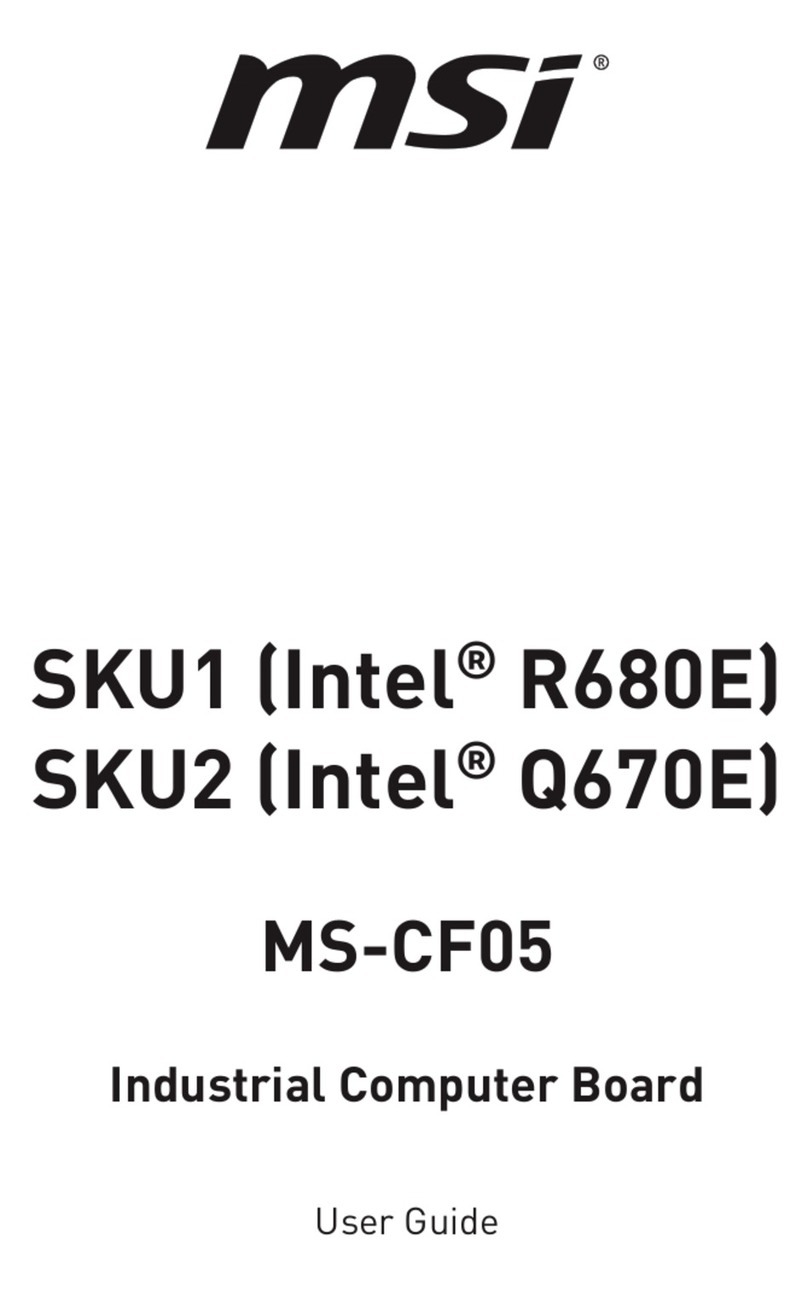
MSI
MSI MS-CF05-SKU1 user guide

Crest Audio
Crest Audio NC-SLM - TECHNICAL Technical data
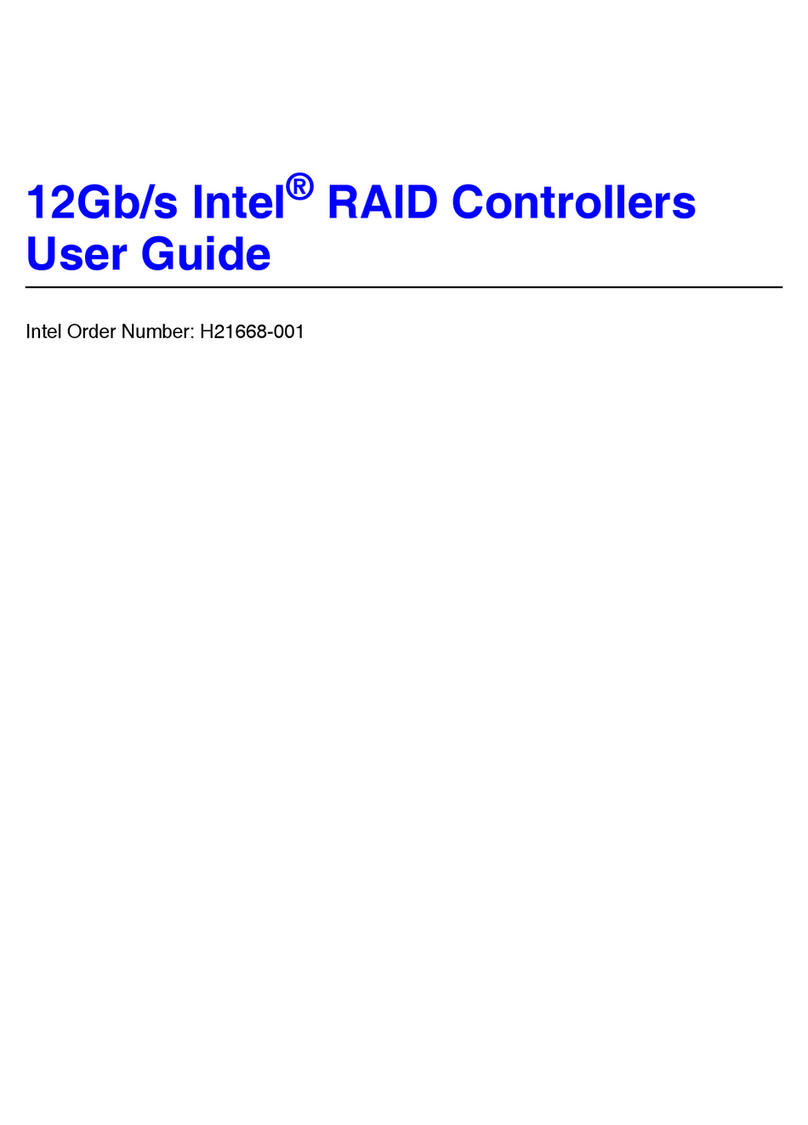
Intel
Intel 12Gb/s user guide
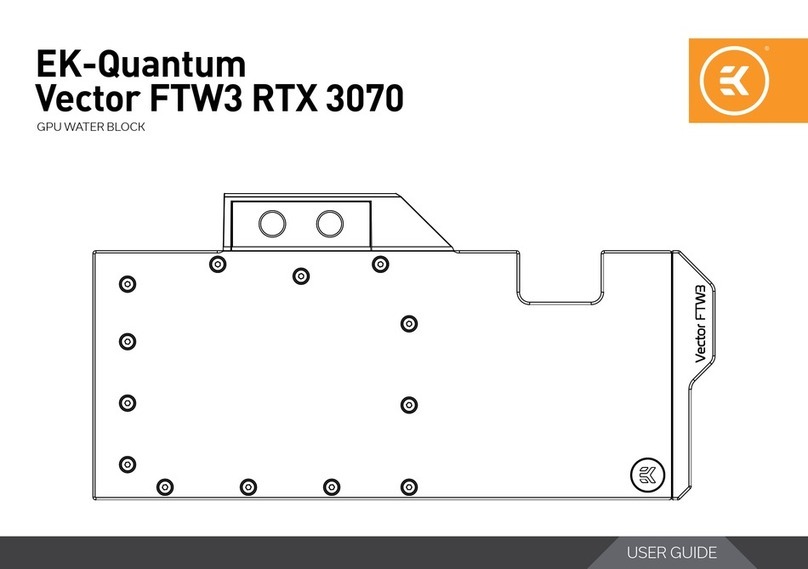
ekwb
ekwb EK-Quantum Vector FTW3 RTX 3070 user guide

ASRock Industrial
ASRock Industrial SBC-250J Settings guide
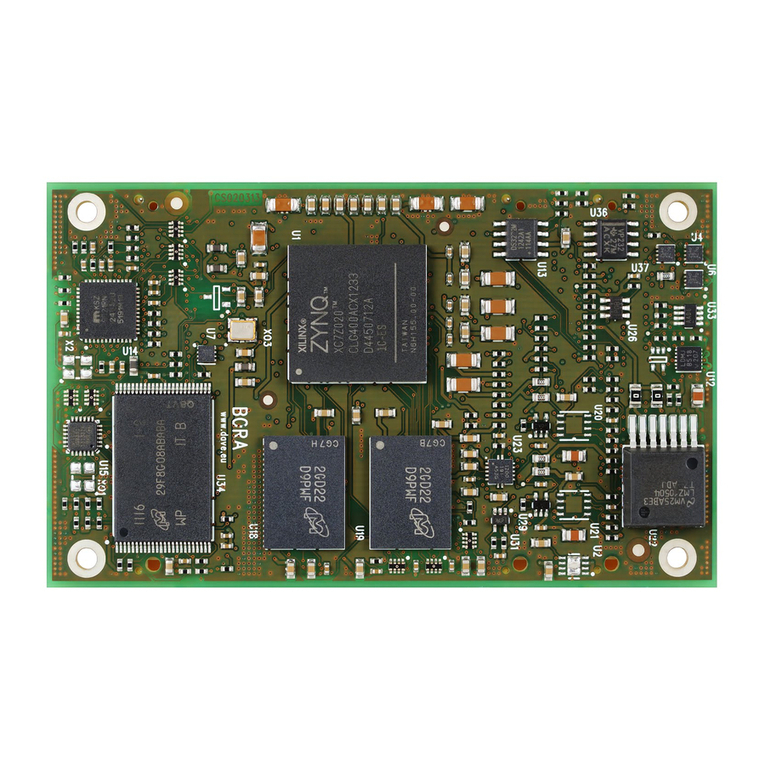
Dave Embedded Systems
Dave Embedded Systems ARM Cortex-A9 MPCore quick start guide
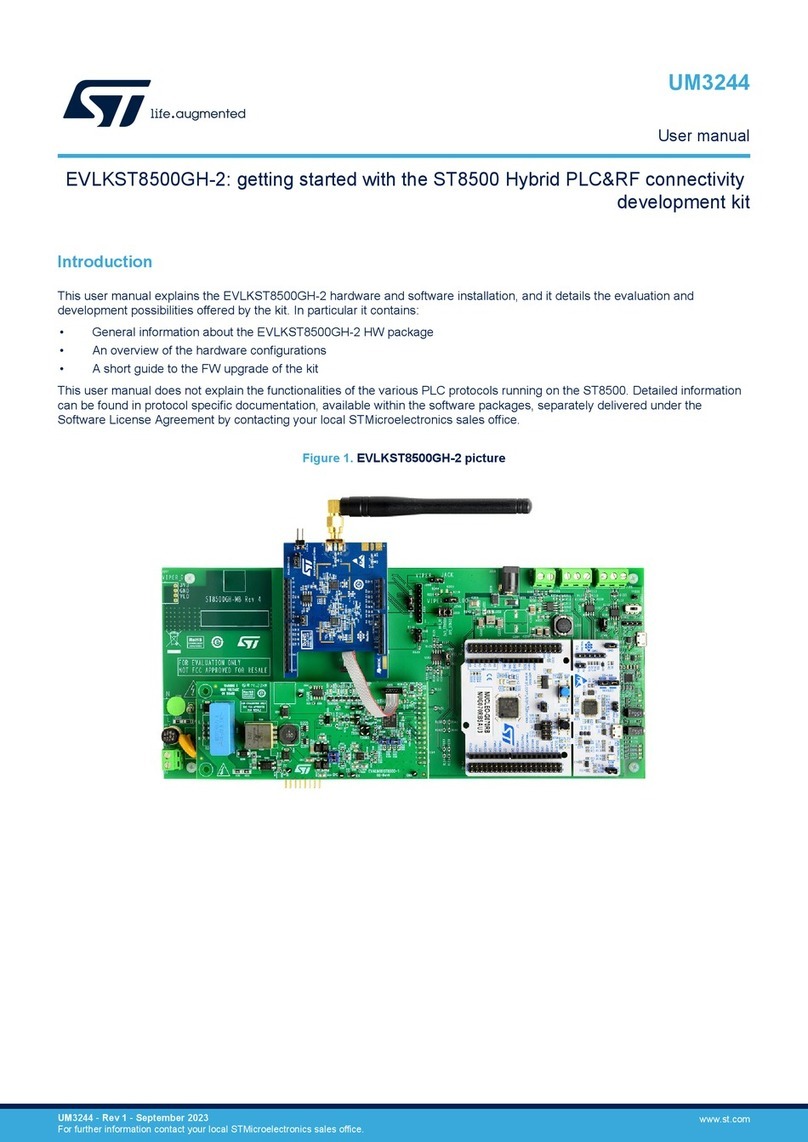
ST
ST EVLKST8500GH-2 user manual
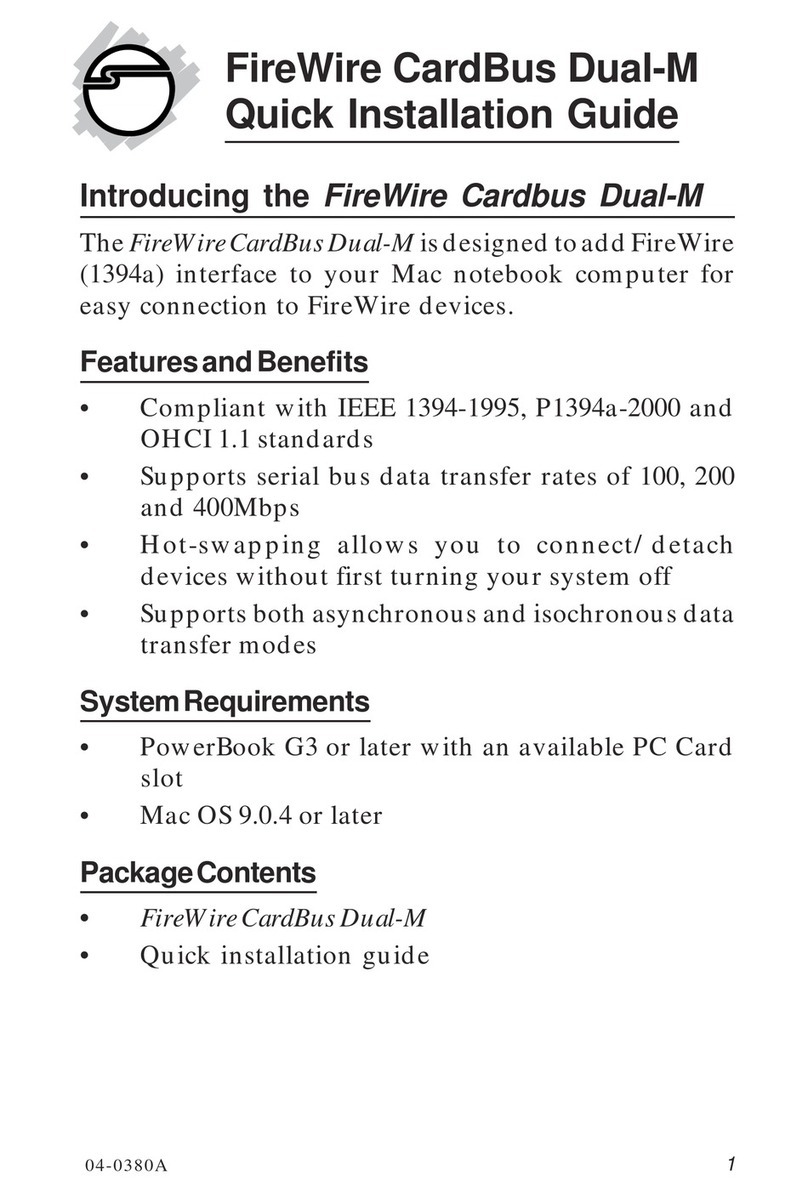
SIIG
SIIG NN-PCMM12-S3 Quick installation guide

Rohm
Rohm BD9P108MUF-TSB-001 user guide

Intel
Intel LGA1155 SOCKET - THERMAL MECHANICAL S AND DESIGN GUIDELINES... installation instructions
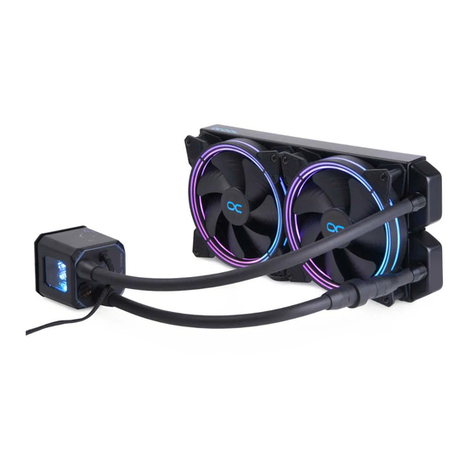
Alphacool
Alphacool EISBAER AURORA manual

Panasonic
Panasonic ET-MDNFB10 operating instructions
